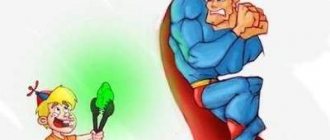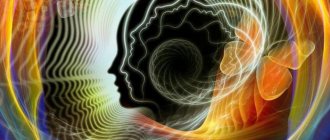Types of VSD
Vegetative-vascular dystonia is directly related to disruption of the autonomic nervous system, which is responsible for adapting the body to different environmental conditions and maintaining the internal state of all systems at the required level. If deviations from the organs occur, an immediate reaction occurs, expressed in VSD.
Dystonia comes in 4 types:
- hypertensive type – a person’s blood pressure rises above 140 mmHg. Art., then abruptly returns to normal;
- hypotonic type - systolic blood pressure suddenly drops and then returns to normal;
- cardiac type – there are constant interruptions in the functioning of the heart, the heartbeat rhythm is unstable;
- mixed type - has features of several types of vegetative-vascular dystonia at once, cannot be classified as one specific one.
Most often, dystonia manifests itself in childhood or adolescence, when a teenager is especially susceptible to stress and mental stress. Symptoms become most pronounced by the age of 20-40. Moreover, women are more susceptible to the disease.
Based on severity, there are 3 types of hypotonic VSD:
- mild - symptoms are almost invisible, periods of remission are long, and exacerbations are short-lived;
- medium – symptoms become varied and more pronounced, frequent pain in the heart appears, exacerbations can last several months;
- severe - the signs of the disease are very clear, the pressure is always low, the exacerbation lasts a long time and requires mandatory treatment.
According to the ICD, all types of VSD, including hypotonic, belong to category F45.3. Their correct medical name is somatoform autonomic dysfunction of the nervous system. Hypotension is low blood pressure and has code I95.
Often other serious diseases that require other treatment are attributed to VSD.
Manifestation of the disease
The appearance of signs of vegetative vascular dystonia of the hypotonic type is a peculiar way of the body to fight and overcome a certain stressful situation. Common manifestations of the disease include:
- frequent, unmotivated malaise;
- constant fatigue;
- low productivity.
Each sign is nonspecific. Symptoms may appear separately in other diseases. But with their complex formation against the background of cardiac or vascular signs, one can think about VSD. Especially if there are various psychotraumatic events in the patient’s life.
The main diagnostic sign for hypotonic VSD is persistently low blood pressure under various conditions. It does not depend in any way on the influence of external factors. The presence of vegetative-vascular dystonia of this type often leads to mental disorders. Patients are terrified of the incurability of the disease. Against the background of this condition, panic attacks, neurotic and depressive states occur.
There are categories of people whose risk of developing the disease is much higher than others. These include:
- young people;
- female;
- hypodynamic lifestyle.
The first signs of the disease may appear in childhood. Over time they only progress. With age, the pathology clinic disappears (the child has “outgrown” the disease). Constantly low blood pressure has an extremely adverse effect on the functioning of many organs and systems.
Heart problems
Cardiac disorders in hypotonic dystonia are subjective complaints arising from problems with the heart and blood vessels. These include pain syndrome. It has a periodic, aching character. But it can be accompanied by various sensations:
- not localized, radiating to different parts of the tube;
- often accompanied by a feeling of lack of air, difficulty breathing, “lump in the throat,” numbness of the tongue and limbs;
- during an attack, all kinds of phobias and other mental disorders may appear;
- the pain is not associated with physical activity and is not relieved by Nitroglycerin;
- The attack can last for different periods of time.
To relieve the condition, sedatives, antidepressants, and sleeping pills are used. This once again confirms the psychological nature of the pathology. In milder cases, this type of dystonia is not manifested by pain, but by minor discomfort in the sternum area.
Rhythm disturbance manifests itself in the form of irregular heartbeat, tachycardia. This is the second most common sign of cardiac damage. During an attack, a vivid clinical picture of vascular reactions is observed:
- cyanosis of lips, mucous membranes;
- pallor or hyperemia of the skin;
- hot flashes or chilliness;
- coldness of the extremities.
Such signs are always accompanied by general malaise, dizziness, and a feeling of lack of air. All of them are not associated with any load.
Additional symptoms
Jumps in blood pressure are the most striking and obvious distinctive sign of VSD. Jumps are observed after overexcitation or against the background of the appearance of other signs of illness. Hypotension is usually accompanied by severe migraine and palpitations. If the drop in pressure is sharp and significant, there is a risk of developing a fainting condition.
With vascular dystonia, the development of the so-called hyperventilation syndrome is noted. This is a kind of psychophysiological reaction of the respiratory organs. Hyperventilation syndrome appears only when inhaling. This makes it possible to distinguish it from signs of asthma, in which suffocation occurs on exhalation.
Complaints from hyperventilation may vary. Typically, the attending doctor during examination reveals:
- muscle tension;
- rapid breathing;
- breathing discomfort that occurs without any external cause.
Such manifestations are not associated with pathologies of the respiratory and endocrine systems, or with the use of medications. It has been proven that shallow, frequent breathing leads to a drop in CO2 concentration in the blood. This provokes alkalization of the blood and depression of the respiratory center. The condition is regarded by the body as dangerous. Because of this, muscle-tonic and motor disorders occur, sensitivity decreases, and migraines appear. Other vegetative-bodily symptoms may be observed:
- feeling of lack of air;
- incompleteness or difficulty in inhaling;
- heaviness in the chest;
- a sharp attack of shortness of breath;
- tremor of the limbs;
- tachycardia, hypotension.
Due to the alkaline content in the blood, the following often occurs:
- frequent yawning;
- sighs;
- sniffling.
Hyperventilation does not manifest itself as symptoms of hypertension, but gastrointestinal disorders (nausea, belching, increased peristalsis) are common. To stop an attack, it is recommended to breathe into folded palms or into a paper bag. This effective procedure is performed because it normalizes breathing. Air enriched with carbon dioxide has a beneficial effect on the respiratory center.
Dyspepsia with VSD
In almost 100% of cases, vegetative-vascular dystonia is accompanied by various types of digestive disorders. The syndrome includes:
- aching, cramping pain in the abdomen;
- stool disorder;
- bloating;
- flatulence.
Soreness appears after a meal or immediately after an episode of stress and nervousness. Often the disease is accompanied by a sign of “irritable bowel”, which occurs mainly in anxious and depressed people. There are other disorders:
- loss of appetite to anorexia;
- gastrointestinal motility dysfunction;
- dysphagia.
Upon examination, there are no objective reasons for this condition. Hypotonic VSD is a difficult condition. It includes a wide range of different disorders. And the main reason for this condition is a violation of the autonomic nervous system.
First of all, lethargy, apathy, and indifference to the life of such patients attract attention. This disease is characterized by a variety of regulatory complaints:
- impaired sweating - manifested by increased sweating of the soles and palms;
- failure of thermoregulation - a slight but persistent increase or decrease in body temperature (often accompanied by chills);
- urinary dysfunction - frequent urge to urinate with pain, but without therapeutic signs of illness;
- sexual dysfunction - in women this condition is manifested by the inability to achieve orgasm, vaginismus; in men - deterioration of erection and ejaculation, signs of impotence with preserved sexual desire.
Many patients complain of frequent irritability, tearfulness, frequent headaches, and sleep disturbances. Vascular dystonia is often associated with disorders of salivation and lacrimation. Qualified, adequate assistance is possible only with timely access to a doctor. Self-treatment of hypotonic type VSD can only aggravate the condition.
Causes
The cause of vegetative-vascular dystonia of the hypotonic type can be any of many factors. People who lead an inactive lifestyle are most at risk of developing this disease. This is especially true for those who suffer from problems with the cardiovascular system and hypotension. There is also a high probability of encountering the disease in children who do not get enough rest and study too much.
Main reasons:
- heredity - genetic predisposition increases the risk that a child will suffer from VSD if the parents have such a disease;
- regular stress and severe fatigue - an increased amount of work or study, complemented by a lack of proper rest and sleep, often causes VSD;
- infectious diseases - exposure to any infection reduces the effectiveness of the immune system and disrupts the functioning of the heart, which can result in dystonia;
- Traumatic brain injuries – serious injuries from an accident or even minor injuries from a fall can cause dystonia years later;
- hormonal imbalances - disturbances in hormonal balance easily cause VSD; they usually occur during pregnancy, menopause or adolescence;
- bad habits - excessive drinking or smoking destroy the nervous system, which often leads to autonomic disorders.
Often it is not possible to identify the real root cause of VSD. Usually this does not cause any problems. But to exclude remission, it is important to identify the factor that stimulates the manifestation of dystonia and get rid of it.
Symptoms of VSD in adults
Symptoms of VSD in adults can be identified as follows:
- Disorders of the heart and blood vessels.
This is expressed in heart pain, surges in blood pressure, and irregular heart rhythms. Disturbances in the functioning of the autonomic nervous system affect heat transfer, which causes frequent hot flashes or cold feet, even in hot weather. A person feels an increase in heart rate quite clearly. Patients often compare tachycardia against the background of VSD with heartbeats against the chest. At such moments, a person may experience a panicky fear of death, a feeling of suffocation, dizziness, and an increase in weakness.
- Disturbances in the functioning of the digestive organs.
These symptoms are varied and are expressed by abdominal pain, problems with normal intestinal motility, increased discharge of gases, etc.
- Respiratory disorders (Da Costa syndrome, irritable heart syndrome, effort syndrome).
The most striking manifestations of respiratory disorders against the background of VSD can be called the appearance of spasms in the larynx. This leads to the fact that a person begins to experience a lack of air. It's as if a lump is forming in the throat. Sometimes the nose becomes stuffy. To get rid of breathing problems, a person begins to cough, sniffle, and breathe deeply. Against the background of respiratory disorders, headaches, presyncope and even fainting develop. A veil appears before the eyes, noise appears in the ears. Frequently associated with respiratory disorders are discomfort such as belching, stomach turmoil, and nausea. In addition to spasms of the larynx, a person may experience spasms of the feet, legs, and arms. They feel like shivering, like chills.
- Malfunctions of the genitourinary system.
In adults, libido decreases, and men may develop impotence. Orgasms may also disappear, or erections will be weak. Urgent urinary incontinence is a symptom that occurs in some patients with VSD. In this case, there will be no pathologies of the urinary system.
- Problems with sweating.
Excessive sweating is observed for a long time or bothers a person periodically. Sweat is released especially profusely during emotional shock and excitement.
- Disturbances in the functioning of muscles and joints.
Seals may appear in various parts of the spine, and from time to time a person experiences pain in the joints and muscles.
- Disorders of lacrimation and salivation.
Eyes with VSD may water, or, on the contrary, they may be too dry (the latter condition develops less frequently). As for salivation disorders, saliva production can be either too abundant or insufficient.
- Emotional disorders.
The person becomes restless and irritable. His performance suffers and he gets tired faster. Most often, people with VSD have a low mood and a tendency to tearfulness.
- Thermoregulation disorders.
Body temperature may remain elevated or decreased for a long time for no apparent reason. Sometimes a person feels chills, which is expressed by trembling in the limbs. Low-grade fever with VSD may remain unchanged for several years. Moreover, taking antipyretic drugs does not lead to its reduction. However, during a night's rest she returns to normal.
Symptoms
With vegetative-vascular dystonia of the hypotonic type, a lot of symptoms can appear. Some of them often raise suspicions that the patient is developing a serious illness that requires urgent treatment. Therefore, the diagnostic procedure may lead the doctor to the wrong place, and the therapy may become incorrect. The same thing happens in the opposite direction - when a dangerous pathology is not seen because of confidence in the VSD.
Symptoms of VSD of the hypotonic type:
- cephalgia, sometimes with pain in the throat;
- cold feet or hands, their periodic trembling;
- pale skin, impaired thermoregulation;
- burning sensation in certain parts of the body;
- irregular heartbeat, pressure surges;
- rapid breathing, lack of air, nasal congestion;
- tinnitus, hiccups, dry cough;
- problems sleeping, increased fatigue, frequent yawning;
- decreased performance, irritability;
- severe weakness, which sometimes ends in fainting;
- tearfulness, decreased tear production;
- lack of appetite, difficulty swallowing;
- nausea, diarrhea, bloating;
- impaired salivation.
During pregnancy, the manifestations of VSD may be somewhat different. Many girls experience a sudden feeling of fear, suffer from insomnia and loss of strength. In some cases, the limbs seem frozen and begin to tremble, while the face, on the contrary, “burns.” This may cause dizziness, swelling or increased sweating.
Often, some signs of illness in a child seem to adults like ordinary fatigue or whims. Therefore, going to the doctor is not even considered.
Is it worth using additional diagnostics to make a diagnosis?
To confirm VSD of the hypotonic type, additional diagnostic methods are used. This is necessary in order to exclude other diseases with similar manifestations. And only if the examination results are within normal limits, or the deviations are actually characteristic of vegetative-vascular dystonia, can this diagnosis be made.
Examination methods and their results:
- General blood test: no changes.
- Biochemical blood test: normal.
- Electrocardiography: sinus bradycardia, extrasystole, negative T wave.
- Test with hyperventilation: 30-45 s the patient takes deep breaths and exhales; after this, an electrocardiogram (ECG) is recorded and compared with that recorded before the test. The test is positive if the heart rate (pulse) has increased by 50-100% of the original value or the T wave has become negative (mainly in the chest leads).
- Orthostatic test:
- An ECG is recorded while lying down;
- then the patient stands for 10-15 minutes and the electrocardiogram is taken again;
- a positive result is recognized if the pulse increases and the T waves become negative (usually in the chest leads).
- Potassium test:
- registration of the initial ECG in the morning, on an empty stomach;
taking 6-8 g of potassium chloride in 50 ml of juice or unsweetened tea;
- a repeat electrocardiogram is taken after 40 minutes and 1.5 hours;
- The result will indicate VSD when the initial negative or reduced T became positive.
- Beta blocker test:
- initial ECG recording;
- taking 60-80 mg of obzidan (anaprilin) in tablets;
- repeat electrocardiogram after 60-90 minutes;
- The result of the study in a patient with VSD: ST depression disappears, negative or low T levels become positive.
- Bicycle ergometry results:
- decreased performance and exercise tolerance;
- an increase in heart rate by more than 50% of the original;
- prolonged tachycardia (frequent heartbeat), the rhythm is restored only after 20-30 minutes;
- the appearance of a deep S wave in the first lead and Q wave in the third;
- deviation of the electrical axis to the right;
- normalization of the T wave;
- short-term shift of ST below the isoline by no more than 1 mm.
These changes are very similar to those in coronary heart disease. But the difference is that with VSD they do not occur at the height of the load, but during rest.
- Phonocardiography: additional tone in systole and not pronounced systolic murmur.
- Echocardiography: no changes. Some patients experience mitral valve prolapse.
- X-ray examination of the chest organs: no changes.
- Spirography: some patients experience an increase in minute respiratory volume.
- Measuring body temperature.
- Measurement of blood pressure (BP) in both arms and legs.
- 24-hour blood pressure monitoring (Holter blood pressure).
- 24-hour electrocardiogram monitoring (Holter-ECG).
- Consultation with an otolaryngologist, neurologist, psychotherapist.
Diagnostics
It is very difficult to make a correct diagnosis of VSD. To do this, you may need to consult several specialists at once: a therapist, a neurologist and a cardiologist. Usually, suspicions of dystonia appear if the patient complains of dizziness, darkening of the eyes, paroxysmal cephalalgia and disturbances in breathing or heart function against a background of general weakness, but he does not have any pathologies or signs thereof. To determine whether he really has VSD, the patient is prescribed a diagnosis.
The examination includes:
- general blood and urine tests;
- electrocardiography;
- daily cardiogram;
- ultrasound examination of the heart;
- rheovasography;
- radiography of the heart;
- electroencephalography;
- MRI or CT scan of the brain.
Additionally, the doctor may prescribe a gastrointestinal endoscopy. This is necessary to assess the condition of the mucosa. Also, if there are suspicions of other pathologies, appropriate referrals may be issued.
Panic attacks with VSD
Panic attack and vegetative-vascular dystonia are two completely different conditions, but due to the similarity of symptoms they are often confused. During an attack of dystonia and a panic attack, adrenaline, norepinephrine and acetylcholine are released into the blood. Therefore, many experts diagnose people prone to panic attacks with VSD. But this is a fundamentally wrong conclusion. To get rid of dystonia, a person must take medications, and to stop panic attacks, you need to seek help from a psychotherapist.
In fact, it is quite easy to confuse VSD and a panic attack, and in the CIS countries doctors do not recognize such a diagnosis as a panic attack, so all patients are treated for dystonia. Although there is no need to take medications to get rid of panic attacks. A person only needs psychotherapeutic help. It will help stabilize blood pressure and get rid of headaches and heart pain. Properly structured interaction with a specialist will make it possible to gradually completely eliminate panic attacks, since they are a neurosis. While vegetative-vascular dystonia is a disorder in the functioning of the sympathetic and parasympathetic parts of the autonomic nervous system. This condition requires medication correction.
Treatment
The disease is not classified as dangerous, but still requires mandatory treatment. Without it, the patient may experience seizures, urinary incontinence, cardiovascular disorders, gastritis and a number of other abnormalities. An integrated approach to therapy is very important for successful recovery. You cannot limit yourself to drug treatment alone, although it is the main one.
Usually, doctors prescribe drugs of several categories and directions for the treatment of hypotonic type VSD. They help normalize the functioning of the nervous system, and also suppress a number of symptomatic manifestations of dystonia.
Main categories of drugs:
- nootropic drugs (“Piracetam”, “Picamilon”);
- antihypertensive drugs (“Ginkofar”, “Memoplant”);
- antidepressants (“Cipralex”, “Amitriptyline”);
- tranquilizers (Relium, Phenazepam);
- venotonics (Eskuzan, Detralex).
Other medications that have a narrower focus may also be prescribed. For example, “Betaserk” for noise inside the head. Along with this, patients are prescribed vitamins that have a positive effect on the autonomic nervous system.
Popular substances:
- thiamine;
- retinol;
- riboflavin;
- pantothenic acid;
- pyridoxine;
- cyanocobalamin;
- ascorbic acid;
- vitamin D;
- tocopherol;
- niacin.
Some tablets may be mutually exclusive or incompatible with a number of pathologies the patient has. Therefore, prescribing medications to yourself without consulting a doctor is strictly prohibited.
Almost all men with VSD are taken into the army. The only exceptions will be those cases when there is documentary evidence of fainting, which occurs at least once a month.
How to treat
Therapy is carried out after a comprehensive examination. Its goal is to exclude organic pathology. For this you will need:
- blood pressure measurement;
- 24-hour blood pressure monitoring;
- ECG;
- Holter monitoring;
- X-ray examination of the chest organs;
- general and biochemical blood tests;
- lipid profile;
- general urine analysis;
- Ultrasound of the heart;
- physical examination;
- survey;
- study of the initial state of the autonomic nervous system;
- electroencephalography;
- Ultrasound (performed in the presence of dyspepsia).
Treatment of VSD of the hypotonic type is carried out after consultation with a cardiologist and neurologist. Therapy includes:
- Elimination of etiological factors (elimination of stress, giving up bad habits, normalizing work and rest schedules, ensuring sufficient night sleep, reducing time spent on mental work, the monitor and TV screens).
- Use of medications. They are prescribed if other treatment methods do not help get rid of symptoms.
- Therapeutic exercise.
- Massage.
- Relaxation.
- Proper nutrition.
- Rest in a sanatorium. It is useful for patients to visit climatic, mud or balneological resorts. Treatment in seaside sanatoriums has a healing effect. Highly ionized sea air and salt water, which contains various compounds (selenium, iodine, magnesium, manganese, calcium, magnesium) that have a beneficial effect on the nervous system, are beneficial. The sanatoriums offer treatment with mountain air, speleotherapy (staying in salt rooms), sunbathing, contrast showers and procedures using sea products.
- Physiotherapy (electrosleep therapy, electrophoresis with caffeine or calcium, magnetic therapy).
- Psychotherapy.
- The use of folk remedies. For hypotension, decoctions and infusions based on herbs that increase blood pressure can be used. These include ginseng, Aralia Manchurian, tansy, Eleutherococcus, St. John's wort, juniper, Rhodiola rosea, Schisandra chinensis and dandelion. It is possible to use a collection based on May honey, hop cones, Rhodiola root and Echinacea flowers.
Important information: List of remedies for VSD (vegetative-vascular dystonia)
Drugs
Drugs for VSD are prescribed only in extreme cases. The following medications can be used:
- Psychotropic drugs (anxiolytics, neuroleptics, sedatives). These include Relium, Valocormid, Novo-Passit and Sonapax). Prescribed in case of neuroses and other mental disorders.
- Adaptogens and drugs with hypertensive effects (ginseng tincture and Eleutherococcus extract).
- Medicines that improve blood circulation and metabolic processes (Vinpocetine).
Often, for vegetative-vascular dystonia of the hypotonic type, Glycine, pantothenic acid and vitamin-mineral complexes are prescribed.
Diet
VSD of the hypotonic type can be treated with diet. To do this you need to do the following:
- Include foods high in salt in your menu. It contributes to a rise in blood pressure.
- Avoid alcoholic beverages.
- Eat more fresh fruits and vegetables.
- Include porridge (buckwheat and oatmeal), fish and seafood in your daily menu.
- Enrich your diet with foods containing calcium, magnesium, ascorbic acid, bioflavonoids, retinol and vitamin E.
- Reduce consumption of foods rich in food additives, chocolate, fatty and fried foods, canned food, baked goods.
- Drink herbal tea, which raises blood pressure.
- Enrich your diet with spices and various flavoring substances. They enhance the functioning of the glands, thereby increasing blood pressure.
- Eat small portions 4-5 times a day.
- Increase fluid intake, as it helps increase circulating blood volume and increase blood pressure.
With severe hypotension, it is useful for patients to drink coffee, black and green tea, as well as cocoa.
Physical exercise
Physical exercise helps cure VSD. For this pathology the following are useful:
- aerobics;
- swimming;
- walking in the fresh air;
- fitness;
- gymnastics;
- skating and skiing.
Important information: Is it possible to drink coffee with VSD?
Strength exercises, jumping, somersaults, as well as dancing and martial arts are possible. Physical exercise helps strengthen the immune system and increase the overall resistance of the body. It is recommended to start classes with small loads, gradually increasing them. With VSD, it is possible to perform therapeutic exercises (physical therapy). The doctor selects the exercises.
Massage
The treatment regimen for vegetative-vascular dystonia includes massage. The technique for high and low blood pressure is different. For hypotonic form, the following are useful:
- acupressure;
- penetrating, deep movements;
- stroking;
- kneading;
- soft circular movements (most often they complete the procedure).
Hypotension affects the following areas:
- crown center;
- elbow cavities;
- subclavian zone;
- area under the occipital protuberance;
- area just above the medial side of the ankle.
All movements must be strong so that the deepest muscles are affected. It is better if the massage is performed by a specialist with a medical education and an appropriate certificate.
Complementary therapy
Drug therapy for vegetative-vascular dystonia must be supplemented with other methods. They will help treat the disease and speed up relief from unpleasant symptoms that interfere with a full life.
The first important procedure in the fight against VSD is manual therapy. Proper massage can improve blood circulation, relieve symptoms of the disease and stimulate the nervous system. In the absence of special contraindications, it is applicable even for pregnant women. The type of massage is chosen by the attending physician, as it is important to take into account the characteristics of the body and dystonia. Only a specialist can conduct sessions - the help of loved ones in this case can cause more harm.
The second method is exercise therapy. A special set of physical exercises will quickly relieve discomfort in the body and restore the functioning of some systems. Most often, they can be performed at home, but you need to ensure that the load is moderate. The list of exact exercises is selected by a doctor or physical therapy specialist. They usually include walking, breathing exercises, slow jogging, swimming and light weight training.
To this you can add a healthy lifestyle with good nutrition. With the hypotonic type of VSD, it is important to stop drinking alcohol and smoking. You should become a more active person, move more, stop sitting still for too long. If the work is sedentary, then you need to periodically take breaks to walk or exercise. Meals should consist of foods rich in potassium and magnesium, dairy products, fruits, vegetables, green tea and freshly squeezed juices. It is recommended to drink at least two liters of water daily. Meals should be small but more frequent. It is important to reduce the amount of fried and fatty foods.
Clinical picture of dystonia
It is important to pay attention to the small features of the disease so that the treatment is competent and effective. Doctors say for good reason that the symptoms of VSD can have a lot of similarities with other diseases that do not have a direct connection with the functioning of the nervous system and brain activity.
If the picture of symptoms has complex outlines, blood flow in the vessels is impaired, and there is often stress in the patient’s life, after which the pressure decreases, then the doctor has grounds to diagnose dystonia with hypotension.
Preventive measures
Prevention of VSD of the hypotonic type includes general measures to prevent the disease: a healthy lifestyle and elimination of risk factors. Preventive measures should be aimed at increasing vitality:
- optimization of work and rest schedules;
- a full night's sleep;
- balanced diet;
- moderate physical activity in the fresh air;
- timely treatment of diseases of internal organs;
- quitting smoking and alcohol.
Regular examinations with a doctor will help prevent VSD. It is necessary not to start the disease process. Otherwise, from the initial stage the disease will develop into acute or chronic, which will require long-term treatment under the supervision of a qualified doctor. If there are no concomitant diseases, then timely medical intervention will help completely eliminate painful symptoms. People with a hereditary predisposition to VSD especially need to be attentive.
Kinds
Like pathologies, this one has its own types, the differences of which are in the causes of the onset and further development of the disease:
- Hypotonic type . A person with this type of disease may experience low blood pressure, bradycardia, weakened immunity, general weakness, and drowsiness. Externally, such a person can be distinguished by pale skin and cold extremities. The patient himself does not feel a strong impact on his body and notes good health.
- Hypertensive . Here the situation is exactly the opposite. Patients with this type of pathology experience high blood pressure, tachycardia, palpitations, headache, and increased fatigue. Like the previous type, this one has almost no effect on human life.
- Cardiac . This type is very pronounced in terms of symptoms and subjective sensations of the patient. There are often complaints of rapid heartbeat, arrhythmia, a feeling of heart failure, and lack of air.
On this topic
- VSD
8 causes of cardiac dystonia
- Natalia Sergeevna Pershina
- June 9, 2020
Also, vegetative-vascular dystonia is classified by doctors according to severity:
- Mild degree . It is characterized by mild or moderately severe symptoms, which manifest themselves during physical or mental stress. After manifestation, the symptoms also quickly disappear. Exacerbations can occur periodically and over several months or years. Crises do not occur. And if they happen, it is very rare. Performance is maintained or very slightly reduced.
- Average degree . The difference is in the severity of symptoms and the duration of the disease. Basically, the duration is about ten months, sometimes more. The recovery period is shorter. There may be mild to moderate crises. Efficiency is reduced by half, and sometimes lost.
- Severe degree . The symptoms are pronounced and difficult to treat. There may be severe disorders of the cardiovascular system. The duration is very long, periods of remission are very short or absent. Crises are very frequent, mostly severe. Working capacity is greatly reduced or lost temporarily. Requires hospital treatment.
It is worth noting that VSD diseases in their pure form are very rare. Often a mixed pathology is noted (cardiac-hypertensive or cardiac-hypotensive type).
VSD of hypotensive type
Currently, this pathology is not considered serious; people are already accustomed to living with it. Very often, patients make their own diagnosis based on cold extremities, constant drowsiness and pale skin. However, you cannot make a diagnosis or ignore its presence - you cannot do this on your own.
During pregnancy
Symptoms of VSD of the hypotonic type during pregnancy occur in every third woman. Modern life consists of constant stress and overload. Often the disease develops in a latent form, and pregnancy is simply a provoking factor. Signs of VSD in a pregnant woman are basically the same as usual. But in most cases they manifest themselves in the emotional sphere. Fears and anxiety arise about the outcome of childbirth. Exacerbations occur at night, and during the day the disease weakens. VSD usually develops of a mixed type.
The disease most often occurs in the first trimester. It is impossible to predict in advance how the disease will progress. Only constant medical supervision will help eliminate unpleasant symptoms and avoid complications. VSD of the hypotonic type can be an impetus for the development of placental insufficiency and anemia. In this case, the fetus will lack oxygen and nutrients, which will adversely affect its growth and development.
To eliminate VSD during pregnancy, non-drug remedies are recommended. It is imperative to stabilize the emotional state by preventing stressful situations. Medicines are used only under the supervision of a doctor.
Folk remedies
Treatment with folk remedies for hypotonic VSD cannot be carried out with herbs that reduce blood pressure. On the contrary, for this disease, herbal preparations with a tonic and stimulating effect are used: lemongrass, ginseng, eleutherococcus. These are plants that belong to the group of adaptogens. Their use increases the body's defenses, accelerates metabolic processes, and improves self-regulation. There are different forms of such fees in the medical market. To get a positive result, the course of taking herbs must be at least two weeks. It is important to remember that you should not use more than one adaptogen at a time. At home, you can prepare the following decoction from a mixture of medicinal plants:
- one tablespoon each of black currant, barberry;
- two tablespoons each of rose hips, lungwort, stinging nettle;
- mix everything, pour two tablespoons of the mixture into 500 ml. boiling water;
- let it brew for several hours, strain;
- take half a tablespoon three times a day before meals.











